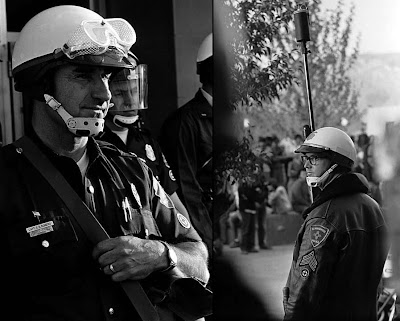What’s Wrong With This Picture?
Forty Years Ago today there was a critical incident at the University of New Mexico.
President Richard Nixon announced a U.S. military incursion into Cambodian during the Vietnam War on April 30, 1970, to interdict North Vietnamese troop movements on the Ho Chi Mien trail.
The announcement set off anti-war protests across the country, many at up to 350 college campuses.
On May 4, 1970, the Ohio National Guard killed four Kent State University students. Two of the victims shot were not participating in the demonstrating of the incursion.

The killings escalated and widened protests. Students at the Albuquerque UNM campus, engaged in demonstrations, marches past federal buildings, above, and ultimately causing the suspension of classes after a fight over the lowering of the American flag to half staff in front of Johnson gym and the take over of the Student Union Building, ended in governmental violence four days later, on Friday, May 8.

Local law enforcement beefed up its patrols, including the use of four man cars, this one, above, monitoring one of the marches is headed by a sergeant.
After the initial “takeover” of the SUB, there were very few students in the building. Early Friday afternoon I observed only six people in the SUB. Tensions were subsiding as the weekend approached.
However, Lt Gov. E. Lee Francis, was acting governor because David Cargo was visiting in Michigan, called out a National Guard unit from Socorro, who along with UNM Police, New Mexico State Police, and Albuquerque Police descended on the SUB. When students and other protesters learned of the law enforcement presence, they reoccupied the building.

As the first ranks of Albuquerque and State Police lined up between the Student Mall and the SUB, there were few protesters outside. Here a man collects badge numbers from Sgt. Norm Courtney and other officers.

APD Traffic Officer Fred Sweitzer with a squad of motorcycle officers are armed with riot sticks as they initially lined up facing the SUB before the crowd grew.

Officers, including APD Capt, Sam B. Romero, above left, converged fully prepared in riot gear of the day while traffic Sgt. Courtney, right, is armed with a shotgun propelled tear gas launchers.
Inside, about 150 anti-war demonstrators occupied the ballroom.

New Mexico State Police Major Hoover Wimberly read the protesters, "the riot act" ordering them to disperse. UNM and NMSP officers affected about 156 arrests. Most, if not all charges, were eventually dismissed, some upon conditional discharge; where after a plea the sentence would be dismissed after a period of unsupervised probation.
The New Mexico National Guardsmen swept up the east side of the student mall with bayonets unsheathed.
There was plenty of press coverage including KOB TV news cameraman Bill Norlander who was seriously wounded when he was one of several people stabbed by the troops. The bayonet strike missed Norlander's aorta by about a quarter inch.

What had started as a student strike ended up being a massive and excessive use of force against students who would have probably returned to class had university leaders announced that classes would resume three days later on Monday.

National Guard troops surrounded the SUB as the first line backed up by civil law enforcement, as the state police helicopter circles overhead.

Wimberly spoke with demonstrator marshals, wearing white headbands, and students in front of the SUB before a crowd that grew to thousands.

So what’s wrong with this picture?

About a half-year earlier, I covered a press conference of the Cambodian Ambassador to the United Nations who detailed an earlier ground incursion. I never saw any coverage in this country for at least a couple of years.
If you Google, US military incursion into Cambodia or US military attack on Cambodia you will find articles that admit there were secret B-52 bombing raids over Cambodia in 1969, but do not address ground attacks. In one
post the "historian" suggested that Cambodian Chief of State, Prince Norodom "Sihanouk did not object to these raids." Sihanouk had been
overthrown by a pro-American right-wing general in March.
This picture, above, proves otherwise that the Cambodians complained. The American people were left in the dark.

Only weeks earlier, Nixon gave his first
speech before the UN's General Assembly invoking Vietnam 24 times, but not once did he mention Cambodia.
Many years later, I met more than one military veteran who admitted they were involved in the 1969 ground raids.

My Take
Four Kent State students were shot for protesting, two killed at Jackson State University in Mississippi, and nine stabbed on the UNM campus, while 24 other campuses where violence erupted. Eleven other students were
killed between 1968 and 1971 protesting.
To this day, the question of why the National Guard units resorted to using
deadly force in non-deadly force situations against students who, at worse might have been trespassing and or disrupting the educational institution, while claiming their First Amendment right to petition government for their redress of grievances, still eludes us.
 This was Memorial Day 1985 at Schofield Barracks, Oahu, Hawaii.
This was Memorial Day 1985 at Schofield Barracks, Oahu, Hawaii. Here, the “Tropical Lightening” Army Band forms up at the Schofield Barracks Post Cemetery.
Here, the “Tropical Lightening” Army Band forms up at the Schofield Barracks Post Cemetery. An Army field artillery unit fires a 21-gun salute.
An Army field artillery unit fires a 21-gun salute. At the end of the ceremony an “echo” taps was performed. The first bugler, left, starts the tune, the second bugler, right, is hidden by a tree while playing the echo. The unit’s flag bearer and artillery officer render a salute.
At the end of the ceremony an “echo” taps was performed. The first bugler, left, starts the tune, the second bugler, right, is hidden by a tree while playing the echo. The unit’s flag bearer and artillery officer render a salute.











